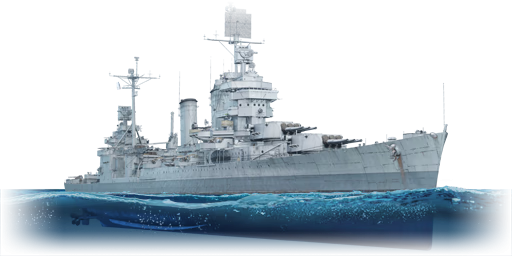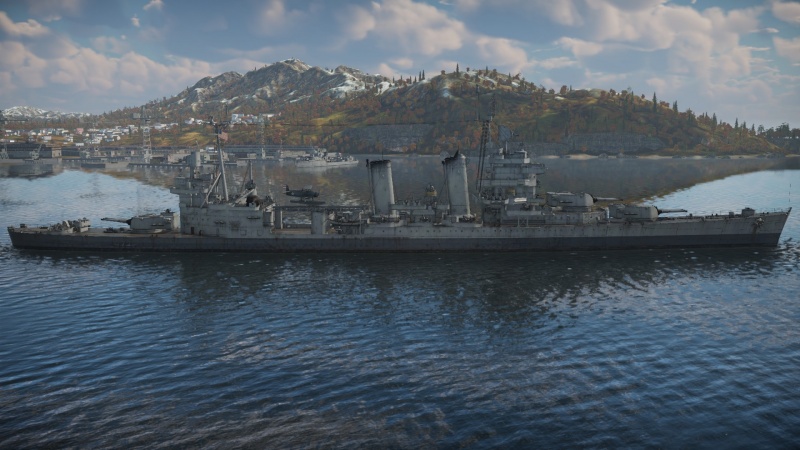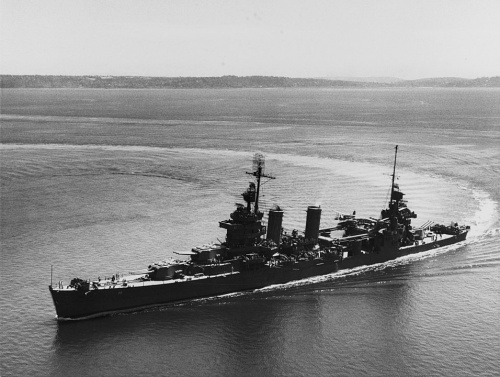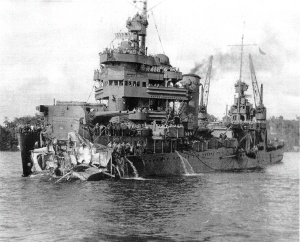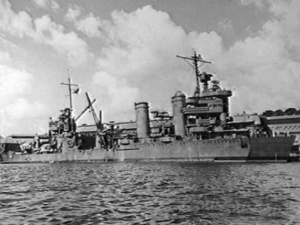USS New Orleans
Contents
Description
The New Orleans-class, USS New Orleans (CA-32), 1945 is a rank IV American heavy cruiser with a battle rating of 5.7 (AB/RB/SB). It was introduced in Update "New Power".
General info
Survivability and armour
Talk about the vehicle's armour. Note the most well-defended and most vulnerable zones, e.g. the ammo magazine. Evaluate the composition of components and assemblies responsible for movement and manoeuvrability. Evaluate the survivability of the primary and secondary armaments separately. Don't forget to mention the size of the crew, which plays an important role in fleet mechanics. Save tips on preserving survivability for the "Usage in battles" section. If necessary, use a graphical template to show the most well-protected or most vulnerable points in the armour.
Mobility
Write about the ship's mobility. Evaluate its power and manoeuvrability, rudder rerouting speed, stopping speed at full tilt, with its maximum forward and reverse speed.
| Mobility Characteristics | |||
|---|---|---|---|
| Game Mode | Upgrade Status | Maximum Speed (km/h) | |
| Forward | Reverse | ||
| AB | |||
| Upgraded | 71 | 25 | |
| RB/SB | |||
| Upgraded | 61 | 22 | |
Modifications and economy
Armament
Primary armament
Provide information about the characteristics of the primary armament. Evaluate their efficacy in battle based on their reload speed, ballistics and the capacity of their shells. Add a link to the main article about the weapon: {{main|Weapon name (calibre)}}. Broadly describe the ammunition available for the primary armament, and provide recommendations on how to use it and which ammunition to choose.
Secondary armament
Some ships are fitted with weapons of various calibres. Secondary armaments are defined as weapons chosen with the control Select secondary weapon. Evaluate the secondary armaments and give advice on how to use them. Describe the ammunition available for the secondary armament. Provide recommendations on how to use them and which ammunition to choose. Remember that any anti-air armament, even heavy calibre weapons, belong in the next section. If there is no secondary armament, remove this section.
Anti-aircraft armament
An important part of the ship's armament responsible for air defence. Anti-aircraft armament is defined by the weapon chosen with the control Select anti-aircraft weapons. Talk about the ship's anti-air cannons and machine guns, the number of guns and their positions, their effective range, and about their overall effectiveness – including against surface targets. If there are no anti-aircraft armaments, remove this section.
Usage in battles
Describe the technique of using this ship, the characteristics of her use in a team and tips on strategy. Abstain from writing an entire guide – don't try to provide a single point of view, but give the reader food for thought. Talk about the most dangerous opponents for this vehicle and provide recommendations on fighting them. If necessary, note the specifics of playing with this vehicle in various modes (AB, RB, SB).
Pros and cons
Summarise and briefly evaluate the vehicle in terms of its characteristics and combat effectiveness. Mark its pros and cons in the bulleted list. Try not to use more than 6 points for each of the characteristics. Avoid using categorical definitions such as "bad", "good" and the like - use substitutions with softer forms such as "inadequate" and "effective".
Pros:
- Very effective AA against aircraft and small targets
Cons:
History
USS New Orleans (CA-32) was the lead ship of her class of heavy cruisers built for the United States Navy. As the last class of 10-thousand ton cruisers built for the US Navy (abiding by the conditions of the Washington Naval Treaty), she was initially classified as a light cruiser and subsequently reclassified due to her 8-inch-calibre main armament. New Orleans had an extensive service history, and travelled abroad prior to the Second World War. During the war, she served extensively in the Pacific Theatre, surviving a crippling torpedo hit that almost sunk her. New Orleans was awarded 17 battle stars for her WWII service, making her one of the five most-decorated American vessels of WWII; her sister ships San Francisco and Minneapolis also made the list. She was decommissioned after the war, and scrapped in 1959.
Design and development
After the construction of the previous Portland, Northampton and Pensacola classes, the United States Navy (USN) began the construction of a new class of heavy cruiser - the New Orleans class. This was the last class of cruisers built to the 10-thousand-ton limit of the Washington naval treaty. The ships were intended to have a much heavier armour load than their predecessors, which were low in survivability. As a result, New Orleans’ armour accounted for almost 15% of her total displacement, compared to 5-6% for the preceding ship classes. However, this resulted in a reduction in fuel stowage meaning that the New Orleans had a shorter range compared to her predecessors.
The ships themselves inherited the superstructure design of the preceding cruiser classes - however, the old tripod mast design was removed and replaced with a smoother forward superstructure. This change made the ships easily-distinguishable from their predecessors and was subsequently used on the Wichita, Cleveland and Baltimore classes of heavy cruisers. The ships, similar to the preceding Portland class, were built directly up to the 10 thousand ton limit; New Orleans herself displaced 9950 tons standard.
Technical specifications
New Orleans carried a main armament of nine 8-inch (203 mm) guns in three triple Mk 9 turrets, later upgraded to Mk 14 turrets during World War II. She also carried a secondary armament of eight single 5-inch 25 calibre guns for anti-aircraft defence. Rounding her armament off, New Orleans carried two 3-pounder (47 mm) saluting guns and eight 12.7mm Browning machine guns for short-range Anti-aircraft armament. In the 1940s, her anti-aircraft armament was improved significantly with 24 40mm Bofors guns in quad mounts and 28 20mm Oerlikon guns in dual mounts.
Similar to other American cruisers, New Orleans didn’t carry any torpedoes. Her engines developed 107 000 shaft horsepower giving her a top speed of 32.7 knots (60.6 km/h). Costing a total of 12 million dollars to build (non-inflation-adjusted), New Orleans was ordered in mid-1929 and laid down in March of 1931. She was eventually completed and commissioned on February 15th 1934.
Operational history
During her construction, New Orleans was reclassified as a heavy cruiser due to her 8-inch main armament. Thus, she was commissioned as CA-32. Following her commissioning, New Orleans sailed on a cruise to the United Kingdom and Scandinavia, followed by a trip to the Panama canal to escort the Northampton-class cruiser USS Houston as she carried President Franklin D. Roosevelt to Hawaii. She later participated in exercises off of California and in the Atlantic, and participated in the first “Fleet week” where civilians could tour the naval vessel.
New Orleans was docked in the inner harbour during the Pearl harbour attack, without power as she was being refueled. Her crewmen frantically tried to raise steam and sail her away while her gunners fired at the attacking aircraft with small arms. As she had no electrical power, New Orleans’ ammunition hoists were inoperational making her 5-inch AA guns nearly useless. Despite this, her crew members attempted to lift shells manually using a rope hoist. New Orleans suffered a near miss from a Japanese HE bomb, but was otherwise unscathed.
In early 1942, New Orleans sailed back to port in San Francisco to repair damage and receive a search radar, along with several 20 mm Oerlikon guns. She then returned to the Pacific, and subsequently saw combat action during the battles of Coral Sea and Midway. During the Battle of the Coral Sea, she tried to save the crippled carrier USS Lexington; she was responsible for evacuating crew members once it was apparent the old carrier could not be saved. She later escorted Yorktown during the Midway battle, but was detached to join the Enterprise battlegroup, and was not present when the Yorktown was crippled by Japanese bombers.
Battle of Tassafaronga
In early November of 1942, New Orleans sailed for Fiji, and then returned to the Solomons for combat action. She was part of a heavy cruiser task force that engaged a Japanese transport squadron during the night of November 30th, in an engagement known as the Battle of Tassafaronga. During the battle, New Orleans, along with four heavy cruisers and six destroyers, spotted a Japanese troop convoy heading for the Solomons, escorted by eight destroyers. And thus began a short engagement limited by poor night-time visibility where the Japanese destroyer Takamani was sunk by gunfire. However, the rest of the Japanese destroyers were not fired upon, and launched a large number of Type 93 ‘Long Lance’ heavy oxygen torpedoes.
At 23:27, Minneapolis was hit by two torpedoes in her engine rooms causing her to take heavy damage. New Orleans subsequently took evasive action, but was hit by a Type 93 that detonated her forward ammunition magazines. As a result, her bow was sheared off at the No. 1 turret and she was slowed to a speed of 2 knots. Subsequently, the cruisers Northampton and Pensacola were both hit, Northampton sinking and Pensacola taking severe damage.
Repairs and later service
New Orleans, with her entire bow sheared off, limped back to Cockatoo dockyard in Australia; in fact, she sailed backwards (stern first) to avoid flooding the ship’s frontal section. There, temporary repairs were made including the fitting of a ‘stub bow’ to cover the blown-off bow section. In March of 1943, she sailed for Puget Naval Yard where she was given a complete repair, and had a new bow section fitted. She also received a large anti-aircraft armament boost of 24 Bofors guns (6 x 4) and numerous more double Oerlikon cannons. Repairs completed, she returned to service in August of 1943.
New Orleans spent the entirety of 1944 in the Pacific theatre, providing heavy fire support for troop landings in the Marshall Islands. She later escorted the Essex-class carrier Lexington (named after the carrier that she attempted to save at the Battle of the Coral Sea) back to Pearl Harbour after she was torpedoed. She later escorted the American carrier task force during the Battle of the Philippine Sea, and participated in the Battle of Leyte Gulf where she sank the light carrier Chiyoda with gunfire.
In early 1945, New Orleans returned to Mare Island for a refit, and then participated in the American invasion of Okinawa where she provided fire support for troops landing on the beaches. She returned to the Philippines in August of 1945, and was anchored at Subic Bay when the Japanese surrendered in Tokyo. She then served in various duties after the war, repatriating American soldiers from China, Japan and the Korean peninsula. She returned to the United States in 1947 and was laid up in reserve, to be scrapped starting in 1959.
New Orleans was awarded 17 stars for her service, making her one of the most decorated ships in American history. In fact, she is tied for third place with three other vessels, two of which are her sister ships: USS San Francisco and USS Minneapolis. The only ships with more stars are the legendary USS Enterprise (20 stars) and the cruiser USS San Diego (18 stars). As well, five ships are named after sailors who perished on USS New Orleans during the battle of Tassafaronga: the destroyer USS Rogers (DD-876), and the destroyer escorts USS Hayter, USS Foreman, USS Swenning, and USS Haines.
Media
Excellent additions to the article would be video guides, screenshots from the game, and photos.
See also
Links to articles on the War Thunder Wiki that you think will be useful for the reader, for example:
- reference to the series of the ship;
- links to approximate analogues of other nations and research trees.
External links
References
- Military Factory. (2017, May 30). USS New Orleans (CA-32). Retrieved January 10, 2021, from https://www.militaryfactory.com/ships/detail.asp?ship_id=uss-new-orleans-ca32-heavy-cruiser-united-states
- Naval History and Heritage Command. (2019, June 26). New Orleans II (CA-32). Retrieved January 10, 2021, from https://www.history.navy.mil/research/histories/ship-histories/danfs/n/new-orleans-ii.html
| New York Navy Yard | |
|---|---|
| Heavy Cruisers (CA) | |
| New Orleans-class | USS New Orleans |
| Battleships (BB) | |
| Tennessee-class | USS Tennessee |
| USA heavy cruisers | |
|---|---|
| Pensacola-class | USS Pensacola |
| Northampton-class | USS Northampton |
| Portland-class | USS Portland |
| New Orleans-class | USS New Orleans |
| Baltimore-class | USS Baltimore · USS Pittsburgh |
| Des Moines-class | USS Des Moines · USS Newport News |


